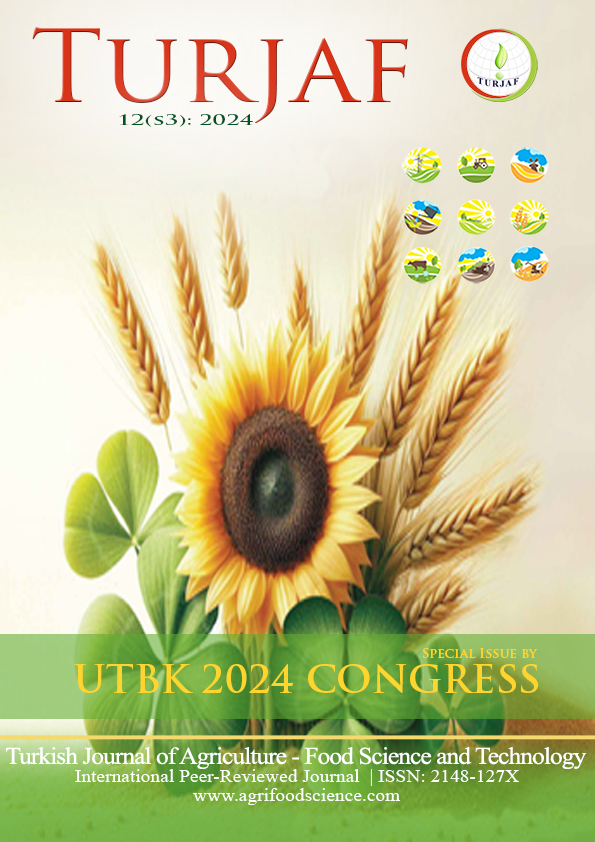The Effects of Different Irrigation Applications and Different Planting Methods on the Yield and Growth Parameters of Paddy
DOI:
https://doi.org/10.24925/turjaf.v12is3.2734-2741.7180Keywords:
Abiotic Stress,, Seedling, Dry Sowing, Yield, PaddyAbstract
Paddy is one of the most important cereal crops, which is a basic food source for more than half of the world's population. In order to feed the increasing world population sustainably, the need to intensify studies on the development of agricultural irrigation methods and efficient use of water resources is increasing. It is estimated that rice uses 34-43% of irrigated agricultural land. Water resources are rapidly decreasing on a global scale and the total amount of irrigation water needed for paddy production varies according to various factors such as the type of paddy used, soil properties and planting methods. The study was designed as a 'Randomized plots' experimental design. In the study, 2 varieties, 2 different irrigation methods (Conventional, AWD) and 3 different planting methods (Irrigated, Dry and Seedling) were carried out in 36 lysimeters as three replications. In the study, characteristics related to rice such as plant height, main stem thickness, cluster length, number of plants per square meter, grain yield, thousand grain weight, yield with and without breakage were examined. It was determined that the research topics had a statistical effect on the parameters examined. In terms of grain yield, it was determined that grain yield decreased by 25% between traditional irrigation and AWD irrigation in water application. In terms of planting methods, Irrigated planting, dry sowing and seedling methods followed each other. As a result of the research, it was determined that the highest grain yield was obtained in the water planting method and with traditional irrigation.
References
Bouman BAM, Tuong TP (2001). Field Water Management to Save Water and Increase Its Productivity in Irrigated Lowland Rice. Agricultural Water Management, 49, 11-30.
Bouman, B. A. M. (2007). A conceptual framework for the improvement of crop water productivity at different spatial scales. Agricultural systems, 93(1-3), 43-60.
Bozorgi, H. R., Faraji, A., Danesh, R. K., Keshavarz, A., Azarpour, E., & Tarighi, F. (2011). Effect of plant density on yield and yield components of rice. World Applied Sciences Journal, 12(11), 2053-2057.
Çamoğlu, G. (2004). Farklı yapımcı ve yapım özelliklerine sahip damlatıcılarda eş su dağılımının incelenmesi.
Düzgün, M., Nigiş, M., & Konuk, H. (1990). Çeltikte çeşit belirleme. Çukurova Tarımsal Araştırma Enstitüsü, Müdürlüğü Yayın, (10), 32.
FAO, 2022. Http://www.Fao.org
Hussain, A. (2013). Economıc analysis of rice crop cultivation in district swat. Journal of Agricultural Research (03681157), 51(2).
Köycü, C., Sezer, İ., & Toksal, A. (1994). Çarşamba ovasında bazı çeltik (Oryza sativa l.) çeşitlerinin bitkisel özellikleri ve tane verimi üzerinde bir araştırma. OM Ü. Ziraat Fakültesi Dergisi, 9(1), 1-11.
Kün E., Sıcak İklim Tahılları. Ankara Ü. Ziraat Fakültesi Yayınları, 953, Ders Kitabı, 275 – 317, Ankara. 1985.
Ogunbayo, S. A., Si&e, M., Ojo, D. K., Sanni, K. A., Akinwale, M. G., Toulou, B., & Gregorio, G. B. (2014). Genetic variation and heritability of yield and related traits in promising rice genotypes (Oryza sativa L.). Journal of Plant Breeding and Crop Science, 6(11), 153-159.
Özgenç N., & Erdoğan, F.C., (1988). DSİ Sulamalarında Bitki Su Tüketimleri ve Sulama Suyu İhtiyaçları. DSİ Basım ve Foto-Film İşletme Müdürlüğü Matbaası, Ankara, 88-91.
Sezer, İ., & Köycü, C. (1999). Kızılırmak Vadisinde Yetiştirilebilecek Çeltik Çeşit ve Hatlarının (Oryza sativa L.) Belirlenmesi Üzerine Bir Araştırma. Türkiye, 3, 15-18.
Sharif, M. K., Butt, M. S., Anjum, F. M., & Khan, S. H. (2014). Rice bran: a novel functional ingredient. Critical reviews in food science and nutrition, 54(6), 807-816.
Şahin, M., Öner, F., Üre, T., & Sezer, İ. (2011). Çeltik çeşit ya da çeşit adaylarının karadeniz bölgesi şartlarında performanslarının belirlenmesi. Ondokuz Mayıs Üni, 4, 133-137.
Şahin, M., Sezer, İ., Dengiz, O., Akay, H., & Öner, F. (2012). Kızılırmak şartlarında yetiştirilen bazı çeltik çeşitlerinin verim performanslarının belirlenmesi. Tarım Bilimleri Araştırma Dergisi, (1), 33-36.
Tabbal D.F., Bouman B.A.M., Bhuiyan S.I., Sibayan E.B., & Sattar M.A. (2022). On-farm Strategies for Educing Water Input in Irrigated Rice; Case Studies in The Philippines. Agricultural Water Management, 56:93-112.
Yadav S., & Reyes, L. (2016). Why invest in optimizing water use in rice farming. Rice Today, 15(2): 34.
Yang C, Yang L, Yang Y, Ouyang Z, (2004). Rice root growth and nutrient uptake as influenced by organic manure in continuously and alternately flooded paddy soils. Agricultural Water Management, 70(1), 67-81.
Yan J, Yu J, Tao GC, Vos J, Bouman BAM, Xie GH, Meinke H (2010). Yield Formation and Tillering Dynamics of Direct-Seeded Rice in Flooded and Nonflooded Soils in The Huai River Basin of China. Field Crops Research, 116(3), 252-259.
Downloads
Published
How to Cite
Issue
Section
License
This work is licensed under a Creative Commons Attribution-NonCommercial 4.0 International License.

























